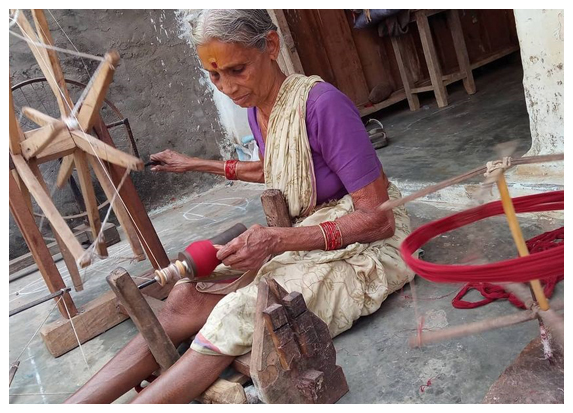The “Field to Fabric” Cotton textile chain that is made using the raw cotton that grows in the vicinity is Decentralised, Sustainable, Collectively owned and Managed by the primary producers, the farmers, ginners, spinners, dyers and weavers.

Until the 19th century spinning was a household activity. India produced enough cotton to cloth its own population and to cloth the world.
In the 19th century, India boasted of many diverse regional varieties of cotton. The indigenous varieties of Cotton were Rain-fed, Grown alongside food crops, kept pests away and replenished the soil. Cotton was grown in regions which are more conducive for growing cotton cultivate cotton and women of surrounding villages in their free time clean, gin (removing seeds and dirt) and card (disentangling and cleaning Cotton fibres to produce a continuous sliver suitable for Spinning). Indigenous variety cotton seeds are stored for planting for the next season and remaining seeds are crushed to make a nutritious cattle feed.
The yarn were spun in scattered locations, generally close to the cotton fields using hand powered wooden equipment the Charaka.Indigenous variety cotton seeds are stored for planting for the next season and remaining seeds are crushed to make a nutritious cattle feed.
The ambar charka is a great innovation which could be installed in cotton growing regions.without huge investments these small-scale units could produce yarn suitable for handloom production within the region. Many villages have clusters of farmers to produce cotton and weavers to weave the fabric, but the produced cotton has to be made to a bale and sent to distant spinning unit and again unbaled to be made to a yarn. This baling and unbaling makes cotton loose its elasticity and finness.
This baling and unabling process was actually introduced by the british to actually source cotton from India at a cheaper rate and convert to fabric at the mills in England, thus eliminating India from being the worlds largest fabric supplier to mere cotton supplier. Coming back to today’s scenario, a few institutions have slightly mechanized handspinning with a solar powered ambar charka called the Solar Charka, to minimize the laborious process of handrotating a heavy ambar charka , but still have low carbon footprint.
Pre-loom Process
When yarn is ready, the next process is preparing the warp and sizing it before it is transferred onto the loom for weaving the fabric. Sizing is unique to the handloom production process and it helps align and strengthen the warp threads for weaving.
Preparing the warp is done by atleast 6 to 8 people if a handspun yarn is used. Warp is spread into long empty streets in early mornings and yarns are strengthened with rice starch. When the warp is set, it is transferred to the loom for weaving the fabric. In a good season, when there are regular orders, warp is set atleast 4 times a week and each person earns around Rs.150 per warp.

Many villages have the skill to produce fine 80s and 100s count (muslin) handspun yarn.
A weaver weaves 2 – 3 metres of fabric per day and takes 4 to 5 days to weave a 11.5 metre fabric ‘thaan’ (general length of a fabric) and is paid Rs.1400, with 2 people making the warp, winding the bobbins, and working on the loom collectively earn around Rs.300 a day. If there are intricate of the pattern saree which can take even 4 to 8 months to weave, the skillfull weaver along with a bobbin maker will collectively earn around Rs.800 per day. In many cases the weaver earns a mere Rs.80 a day. This leads to most of them migrating to nearby cities to dwell in the slums and work as unskilled labours in the cities. Eventually women who stay back in their villages alone take up the weaving without support. They weave in the daytime and wind bobbins in the night for the next days production.